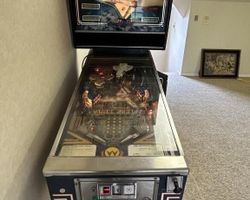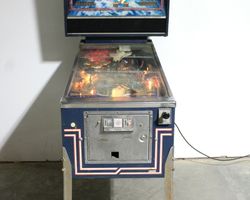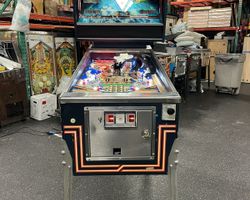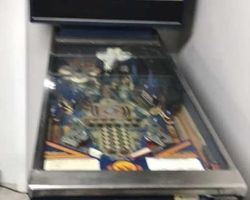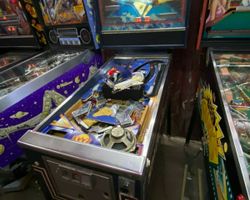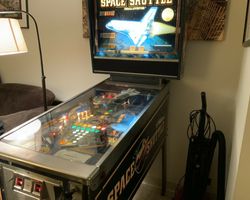Space Shuttle
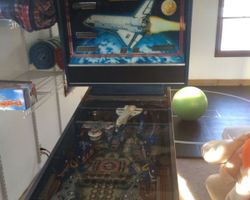
Average Prices: USD $300 to $2,100
Produced: December, 1984
Production Run: 7,000 units
Machine Type: Solid State Electronic
MPU: Williams System 9
Players: 4
Concept by: Joe Kaminkow
Design by: Joe Kaminkow, Barry Oursler
Art by: Mark Sprenger
Sound by: Eugene Jarvis, Bill Parod
Software by: Larry DeMar
In November 1984, Williams Electronic Games, Inc. launched a pinball machine that captured the public's imagination, drawing on a pervasive fascination with space exploration. Titled "Space Shuttle," this machine arrived as a timely reflection of the United States' ongoing space program, featuring its iconic reusable spacecraft. The design and production process for "Space Shuttle" brought together a team of contributors who would leave an indelible mark on pinball. Barry Oursler and Joe Kaminkow collaborated on the machine's design, with Kaminkow also credited for the initial concept. Mark Sprenger brought the theme to life through his distinct artwork, incorporating personal touches such as the initials and birthdate of his son into the shuttle transporters depicted on the playfield. The auditory experience was crafted by Bill Parod and Eugene Jarvis, while Larry DeMar handled the software and speech processing, with Steve Ritchie lending his voice for the custom callouts. Produced in a run of 7,000 units, "Space Shuttle" was a significant release for Williams, running on their robust System 9 MPU, and notably, it was the first solid-state production pinball machine to incorporate a three-dimensional playfield toy, a feature that would become increasingly common in future designs.
Signature Features and Design
"Space Shuttle" established several design benchmarks for its era. The machine's most prominent feature, a plastic replica of the Space Shuttle, is strategically positioned over the center ramp. This physical representation of the game's theme added a tangible element to the playfield, inviting players to directly interact with the very object the game celebrated. Beyond its visual impact, this toy served as a target and integrated mechanism, enhancing the flow and immersion of the game.
The machine diverged from convention by replacing the traditional knocker with a ringing bell for awards, extra balls, and free games. This distinct sound contributed to the machine’s auditory identity. Custom speech, featuring the voice of Steve Ritchie, provided dynamic callouts that guided players and celebrated their achievements, a feature that was evolving rapidly in pinball at the time.
Another practical design element was the "up-post" located between the flippers. This post could deploy to prevent a direct center drain, offering players a brief reprieve and adding a layer of defensive strategy. The digital display provided multi-functional scoring, showcasing not only current points but also special "stop-n-score" tallies, a countdown to multiball activation, and a deluxe match animation. An innovative bonus feature lamp array was capable of displaying scored "stop-n-score" points, the countdown to multiball, spelling out "Space Shuttle" in attract mode, and flashing "Tilt" when necessary. The lighting and visual effects, combined with the game's distinctive sounds, contributed to a captivating experience that defined the aesthetic of early Williams System 9 machines.
Playfield and Mechanics
The playfield of "Space Shuttle" is a well-structured layout designed for dynamic and engaging gameplay. It features two flippers, positioned conventionally at the bottom. Three pop bumpers are situated in the upper playfield, providing unpredictable ball action and high-point opportunities. Two slingshots flank the lower flippers, redirecting the ball with force. The layout includes two kick-out holes and a spinning target, contributing to the diversity of shots available.
Central to the playfield's design are the targets and ramps. A set of three drop targets and a timed drop target offer opportunities for strategic shooting, often activating bonuses or progressing towards multiball. Two ramps, including the prominent center ramp guarded by the Space Shuttle toy, provide clear pathways for players to aim for, directing the ball to the upper playfield or back to the flippers. The right outlane incorporates a detour gate, a limited ball saver mechanism that re-serves the ball or saves it if it fails to trigger any switches after a launch or a ball lock, adding a degree of leniency to the otherwise fast-paced play.
The design philosophy behind the playfield emphasized straightforward objectives and accessible shots, facilitating a brisk pace of play. The artwork, executed by Mark Sprenger, reinforced the machine’s space theme, with detailed depictions of the shuttle and associated transport vehicles. The interplay of artwork, lighting, and mechanical features created a cohesive environment that immersed players in the thematic journey of space exploration.
Gameplay Dynamics
"Space Shuttle" features gameplay mechanics centered around easily graspable objectives, making it approachable for newcomers while offering depth for experienced players. The primary goal often revolves around initiating multiball, which can be achieved through specific shots and target activations. The machine supports both two-ball and three-ball multiball play, providing a rewarding high-scoring opportunity. The scoring system incorporates "stop-n-score" points and bonus multipliers, encouraging players to hit specific targets to maximize their score. Bonus points can be carried over to the next ball in play, except for the final ball, adding an element of strategic planning across the game.
Unique modes and challenges include the straightforward yet compelling task of hitting drop targets, which are integral to advancing game progression and earning bonus points. The center ramp shot is a frequently sought-after objective, providing consistent points and often feeding into multiball sequences. Player strategies often involve aiming for the drop targets to build bonus multipliers and consistently shooting the center ramp to initiate and maintain multiball. The presence of the "up-post" between the flippers offers a defensive strategy, allowing players to save a ball from a direct center drain.
The game's dynamic flow is punctuated by the ease of achieving multiball, creating moments of intense action. While some players find the core loop of achieving multiball and shooting the center ramp can become repetitive, others appreciate its directness and the satisfaction derived from successful execution. The machine's design encourages a fast, aggressive style of play, challenging players to maintain control amidst the rapid ball movement generated by the pop bumpers and slingshots.
Reception and Legacy
"Space Shuttle" quickly garnered a positive reception upon its release and has maintained a strong reputation within the pinball community. It is frequently lauded as a classic, praised for its accessible rules, fast-paced action, and engaging gameplay that encourages "just one more game." Many players recall it fondly from its original arcade run, citing a strong sense of nostalgia. Its arrival is often credited with providing a significant boost to the pinball industry during a period that saw a decline in arcade popularity.
Strengths highlighted by the community include its intuitive rule set, making it welcoming for new players, yet possessing enough challenge to keep experienced players engaged. The integration of the space theme is consistently praised, as is the effective use of lights and sounds for its era. The physical space shuttle toy, being the first in a solid-state production machine, is a celebrated feature, adding a tangible element to the playfield. The accessible multiball mechanic is considered a major draw, providing frequent opportunities for high-scoring, high-energy play. Features like the center post and various ball-save mechanisms are also appreciated for adding an element of forgiveness and strategy.
However, specific feedback also notes areas some players find less compelling. For some, the gameplay loop, heavily reliant on the center ramp and multiball, can lead to a sense of repetition. While the artwork is generally appreciated for its time, some opinions describe it as 'bland' or 'drab' when compared to later, more intricate designs. Similarly, the music and sound effects, while effective for the era, are occasionally described as basic or repetitive. The speech, though custom, is sometimes considered less sophisticated than in subsequent Williams titles. Gameplay challenges include the left outlane, which can be particularly unforgiving, and the unpredictable nature of ball drains from the pop bumpers and slingshots. Some players also point out that the ramp shot, while central, can sometimes lead to an unfortunate center drain, and the placement of certain drop targets can feel awkward. The scoring, for a segment of players, does not always feel substantial enough to sustain long-term interest. Despite these specific criticisms, "Space Shuttle" maintains its status as a foundational Williams machine. Its significance lies in its popularization of the playfield toy and its overall contribution to the resurgence of pinball, influencing subsequent machine designs by demonstrating the appeal of integrated thematic elements and accessible, yet exciting, gameplay.
Sponsored Links
 Ebay Listings
Ebay Listings
 Auction Results
Auction Results
| Cost | Location | Date |
|---|---|---|
| USD $1,150 |  Illinois, United States Illinois, United States |
08 June, 2025 |
| USD $2,650 |  Pennsylvania, United States Pennsylvania, United States |
05 May, 2025 |
| USD $4,889 |  Florida, United States Florida, United States |
28 February, 2025 |
| USD $4,800 |  Illinois, United States Illinois, United States |
08 July, 2024 |
| USD $6,000 |  Florida, United States Florida, United States |
27 April, 2024 |
| USD $2,700 |  New York, United States New York, United States |
08 March, 2024 |
| USD $2,100 |  North Carolina, United States North Carolina, United States |
07 January, 2024 |
| USD $3,200 |  California, United States California, United States |
21 November, 2023 |
| USD $6,999 |  California, United States California, United States |
31 October, 2023 |
| USD $1,000 |  Maryland, United States Maryland, United States |
25 May, 2023 |


Private Policy · Search Website · Contact Us
As an eBay Partner, we may earn a commission from qualifying purchases made through links on this site, at no additional cost to you.
All trademarks and copyrighted materials remain property of their respective owners. All other content copyright 2007 - 2025 Pinpedia.

